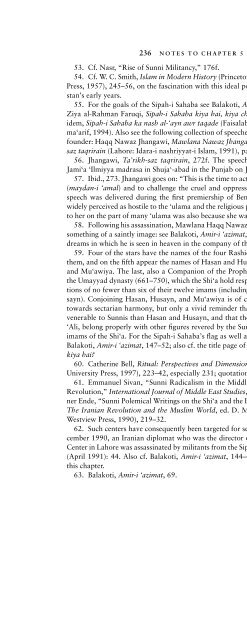Download (1 MB) - Islam and Christian-Muslim Relations: Articles ...
Download (1 MB) - Islam and Christian-Muslim Relations: Articles ...
Download (1 MB) - Islam and Christian-Muslim Relations: Articles ...
Create successful ePaper yourself
Turn your PDF publications into a flip-book with our unique Google optimized e-Paper software.
236 NOTES TO CHAPTER 553. Cf. Nasr, “Rise of Sunni Militancy,” 176f.54. Cf. W. C. Smith, <strong>Islam</strong> in Modern History (Princeton: Princeton UniversityPress, 1957), 245–56, on the fascination with this ideal polity especially in Pakistan’searly years.55. For the goals of the Sipah-i Sahaba see Balakoti, Amir-i ‘azimat, 139–52;Ziya al-Rahman Faruqi, Sipah-i Sahaba kiya hai, kiya chahati hai? (n.p., n.d.);idem, Sipah-i Sahaba ka nasb al-‘ayn awr taqade (Faisalabad: Idara-yi isha‘at alma‘arif,1994). Also see the following collection of speeches by the organization’sfounder: Haqq Nawaz Jhangawi, Mawlana Nawaz Jhangawi ki p<strong>and</strong>ara ta’ rikhsaztaqrirain (Lahore: Idara-i nashriyyat-i <strong>Islam</strong>, 1991), passim.56. Jhangawi, Ta’rikh-saz taqrirain, 272f. The speech was delivered at theJami‘a ‘Ilmiyya madrasa in Shuja‘-abad in the Punjab on June 1, 1989.57. Ibid., 273. Jhangawi goes on: “This is the time to act in the practical sphere(maydan-i ‘amal) <strong>and</strong> to challenge the cruel <strong>and</strong> oppressive ruler” (ibid.). Thisspeech was delivered during the first premiership of Benazir Bhutto, who waswidely perceived as hostile to the ‘ulama <strong>and</strong> the religious parties. The oppositionto her on the part of many ‘ulama was also because she was a Shi‘i <strong>and</strong> a woman.58. Following his assassination, Mawlana Haqq Nawaz has himself been givensomething of a saintly image: see Balakoti, Amir-i ‘azimat, especially 317–18, fordreams in which he is seen in heaven in the company of the sahaba.59. Four of the stars have the names of the four Rashidun caliphs written onthem, <strong>and</strong> on the fifth appear the names of Hasan <strong>and</strong> Husayn (two sons of ‘Ali)<strong>and</strong> Mu‘awiya. The last, also a Companion of the Prophet, was the founder ofthe Umayyad dynasty (661–750), which the Shi‘a hold responsible for the tribulationsof no fewer than six of their twelve imams (including ‘Ali, Hasan, <strong>and</strong> Husayn).Conjoining Hasan, Husayn, <strong>and</strong> Mu‘awiya is of course not an initiativetowards sectarian harmony, but only a vivid reminder that Mu‘awiya is no lessvenerable to Sunnis than Hasan <strong>and</strong> Husayn, <strong>and</strong> that the latter two, as well as‘Ali, belong properly with other figures revered by the Sunnis, not with the laterimams of the Shi‘a. For the Sipah-i Sahaba’s flag as well as other symbolism, seeBalakoti, Amir-i ‘azimat, 147–52; also cf. the title page of Faruqi, Sipah-i sahabakiya hai?60. Catherine Bell, Ritual: Perspectives <strong>and</strong> Dimensions (New York: OxfordUniversity Press, 1997), 223–42, especially 231; quotation is from 231.61. Emmanuel Sivan, “Sunni Radicalism in the Middle East <strong>and</strong> the IranianRevolution,” International Journal of Middle East Studies, 21 (1989): 1–30; WernerEnde, “Sunni Polemical Writings on the Shi‘a <strong>and</strong> the Iranian Revolution,” inThe Iranian Revolution <strong>and</strong> the <strong>Muslim</strong> World, ed. D. Menashri (Boulder: TheWestview Press, 1990), 219–32.62. Such centers have consequently been targeted for sectarian attacks. In December1990, an Iranian diplomat who was the director of the Iranian CulturalCenter in Lahore was assassinated by militants from the Sipah-i Sahaba. Newsline(April 1991): 44. Also cf. Balakoti, Amir-i ‘azimat, 144–45; <strong>and</strong> see table 3, inthis chapter.63. Balakoti, Amir-i ‘azimat, 69.



